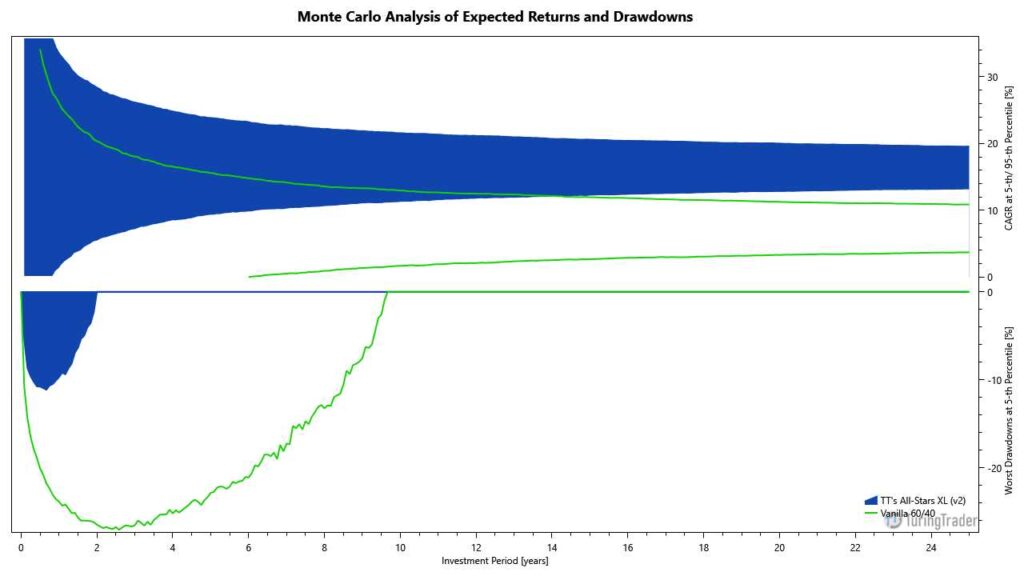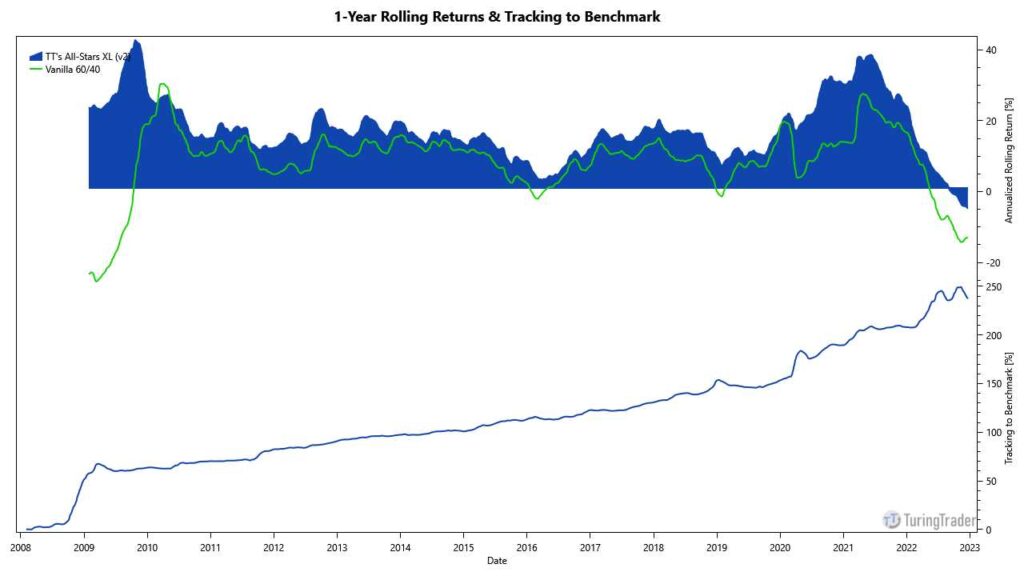Summary
- Objective: aggressive growth
- Type: momentum strategy
- Invests in: ETFs tracking industry sectors and stock-market factors, bonds
- Rebalancing schedule: monthly
- Taxation: 90% short-term capital gains
- Minimum account size: $2,000
TuringTrader’s Round-Robin aims to continually beat the S&P 500 while avoiding deep drawdowns during recessions. The strategy’s algorithm is loosely based on Scott M. Juds SectorSurfer strategies. Under the hood, the strategy switches between separate bull and bear-market models using a market-regime filter. Both models use a low-noise momentum method to rank and select their assets. Round Robin only rebalances its positions once per month and holds no more than two ETFs simultaneously. With these properties, the strategy is an excellent fit for aggressive investors with a longer time horizon or smaller accounts.
Performance
This table shows the portfolio’s key performance metrics over the course of the simulation:
The following chart shows the portfolio’s historical performance and drawdowns, compared to their benchmark, throughout the simulation:
This chart shows the portfolio’s annual returns:
The following charts show the Monte-Carlo simulation of returns and drawdowns, the portfolios 12-months rolling returns, and how the portfolio is tracking to its benchmark:


Asset Allocation
The portfolio last required rebalancing after the exchanges closed on @last-rebal@. Due to fluctuations in asset prices, the exact allocations vary daily, even when no rebalancing occurred. The current asset allocation is as follows:
Sign up for our FREE Basic membership to see the asset allocation.
Sign up for our FREE 14-day trial to see the asset allocation.
Strategy Rules
The operation of Round-Robin can be summarized as follows:
- detect market-regime by combining economic indicators with S&P 500’s momentum and volatility
- in bear markets, use a momentum strategy trading various debt instruments
- in bull markets, use two momentum strategies: one trading sector ETFs, the other trading style-box ETFs
- for each momentum strategy
- create a benchmark through equal-weighting the traded assets
- determine momentum relative to this benchmark
- use walk-forward optimization to continually adjust the momentum filters
Our background article, Low-Noise Momentum Strategies, describes Round-Robin‘s operation in more detail. We adapted the strategy’s mechanics from Scott M. Juds’ book Conquering the Seven Faces of Risk. For those interested in a better understanding of the strategy’s rationale, we recommend reading Juds’ book.
Diversification
Round-Robin typically invests in only two ETFs at a time. While these ETFs cover a wide array of individual companies, the strategy focuses on only one sector and one style. However, as market conditions evolve, Round-Robin rotates from one asset to the next. Juds calls this concept serial diversification.
Round-Robins‘ serial diversification aims to position the portfolio well to cope with current market conditions. The market-regime detection serves as an additional safeguard, allowing to react swiftly to changes in sentiment, and move the portfolio into a risk-off state. The effectiveness of these mechanisms manifests itself in Round-Robin‘s low beta of less than 0.5.
Nonetheless, Round-Robin is first and foremost a stock-market strategy. Therefore, we see its primary use in conjunction with other strategies, which offer diversification into additional asset classes.
Returns & Volatility
Unlike many strategies that beat the S&P 500 index only over the full economic cycle, Round-Robin beats its benchmark in most years. Through switching between separate bull- and bear-market portfolios, the strategy further expands its lead on the benchmark during recession periods.
The Monte-Carlo analysis shows that Round-Robin creates an impressive upside over the S&P 500 benchmark while at the same time maintaining a significantly lower risk profile. Notably, Round-Robin managed to yield positive returns in all of the years simulated and rarely suffered deeper drawdowns than its benchmark.
Account & Tax Considerations
Round-Robin trades frequently and will trigger taxable events regularly. Investors cannot expect to hold any assets long enough to qualify for long-term treatment of capital gains. Therefore, the strategy works best in tax-deferred accounts. However, thanks to Round-Robin‘s significant upside, we expect the strategy to even add value in taxable accounts.
Because the strategy holds no more than two ETFs simultaneously, it can function as intended with account values as low as $2,000.
